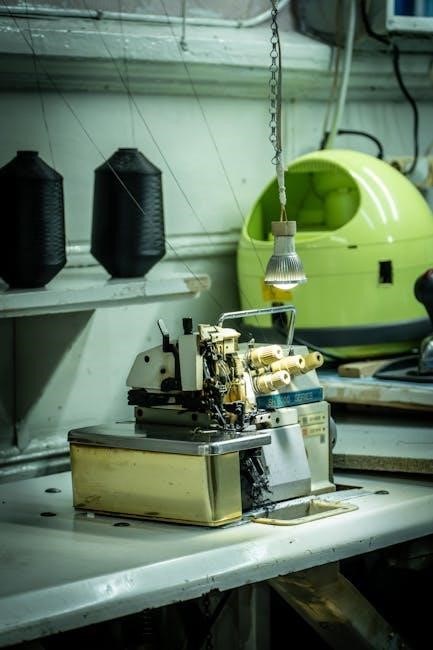
NPTF (National Pipe Tapered Fuel) threads are standardized tapered pipe threads used in various industries. Their dimensions ensure leak-free connections in high-pressure applications, with precise specifications for pitch, diameter, and taper rate. Understanding these dimensions is crucial for proper installation and maintenance in petroleum, aerospace, and industrial systems. This guide provides detailed insights into NPTF thread dimensions, their importance, and applications.
1.1 Overview of NPTF Threads
NPTF (National Pipe Tapered Fuel) threads are a type of tapered pipe thread designed for high-pressure and high-stress applications. They are commonly used in the petroleum, natural gas, and aerospace industries to ensure leak-free connections. NPTF threads feature a tapered shape, which creates a tight seal when threaded components are joined. Their dimensions are standardized to ensure compatibility and reliability across various systems. Understanding NPTF threads is essential for engineers and technicians working with piping systems that require precision and durability.
1.2 Importance of NPTF Thread Dimensions
NPTF thread dimensions are critical for ensuring leak-free connections in high-pressure applications. Their precise specifications guarantee compatibility and reliability across systems. Accurate dimensions prevent thread damage and ensure proper sealing, which is vital for safety in industries like petroleum and aerospace. Standardized dimensions also facilitate easier assembly and disassembly, reducing maintenance challenges. Adhering to these dimensions ensures compliance with industry standards, minimizing the risk of system failures. Proper thread dimensions are essential for maintaining structural integrity and operational efficiency in demanding environments.

Understanding NPTF Thread Specifications
NPTF threads are standardized tapered pipe threads designed for leak-free connections in high-pressure applications, defined by specific pitch, diameter, and taper specifications to ensure reliability.

2.1 Definition and Standards
NPTF (National Pipe Tapered Fuel) threads are a type of tapered pipe thread standardized for use in high-pressure and high-temperature applications. Governed by ANSI/ASME B1.20.2, these threads ensure leak-free connections through precise geometry. The standard specifies thread angles, pitches, and diameters, with a 3/4″ per foot taper. Major and minor diameters, along with thread crest and root truncation, are defined for accuracy. Compliance with these standards guarantees interchangeability and reliability in critical systems, making NPTF threads indispensable in industries like petroleum and aerospace.
2.2 Thread Geometry and Tolerances
NPTF thread geometry is defined by ANSI/ASME B1.20.2, specifying precise dimensions for major and minor diameters, thread angle, and pitch. The 60-degree thread angle ensures a tight seal, while the 3/4″ per foot taper enhances connection integrity. Tolerances for thread crest and root truncation are critical to prevent leakage. These standards ensure compatibility and reliability in high-pressure applications, with strict limits on pitch diameter and lead variations. Adhering to these tolerances guarantees optimal performance and longevity in demanding environments.
Key Characteristics of NPTF Threads
NPTF threads feature a tapered design with a 60-degree angle, ensuring a tight, leak-free seal. Major and minor diameters are precisely specified to meet standard requirements.
3.1 Thread Angle and Pitch
NPTF threads feature a 60-degree thread angle, designed for a tight, tapered connection. The pitch, or distance between threads, is standardized to ensure compatibility. A smaller pitch increases thread engagement, enhancing seal integrity. The thread angle and pitch are critical for achieving a leak-free joint, especially in high-pressure applications. These dimensions are precisely defined in NPTF standards, ensuring consistency across manufacturers. Proper understanding of these measurements is essential for selecting the right components and maintaining system performance.
3.2 Major and Minor Diameters
The major diameter is the largest diameter of the NPTF thread, while the minor diameter is the smallest. These measurements are critical for ensuring proper thread engagement and sealing. The major diameter includes the crest of the thread, while the minor diameter is measured at the root. Both dimensions are tightly controlled to maintain compatibility and performance. Accurate measurement of these diameters is essential for ensuring leak-free connections, especially in high-pressure applications. Proper tolerances for major and minor diameters are specified in NPTF standards to guarantee reliability.
3.3 Taper Rate and Lead
The taper rate of NPTF threads is the rate at which the diameter increases per unit length, typically expressed in inches per inch. The lead, or thread advance, is the distance the thread moves along the axis in one full turn. Both are critical for proper thread engagement and sealing. The taper rate ensures a tight, leak-free connection, while the lead affects the thread’s strength and compatibility. These dimensions are standardized to ensure consistency across applications, with precise tolerances specified in NPTF standards to maintain reliability and performance in high-pressure environments.
NPTF Thread Dimensions in PDF Format
NPTF thread dimensions in PDF format provide detailed charts and tables for standard sizes, tolerances, and specifications. These resources are essential for manufacturing and quality control.
4.1 How to Read NPTF Thread Dimensions from a PDF
Reading NPTF thread dimensions from a PDF involves understanding the layout and key columns. Major diameter, pitch, and taper rate are typically highlighted. Reference tables provide conversions and tolerances. Ensure accuracy by cross-referencing measurements with standards. Use the PDF’s zoom feature for clarity and verify units of measurement. Pay attention to notes and symbols for additional specifications. Always consult the latest version of the PDF for updated information. Proper interpretation ensures compliance with industry standards and reliable connections in high-pressure applications.
4.2 Common Symbols and Abbreviations Used
In NPTF thread dimension PDFs, common symbols include D for major diameter, P for pitch, and T for taper rate. Abbreviations like NPTF (National Pipe Tapered Fuel) are frequently used. These symbols are essential for understanding thread specifications and ensuring accurate measurements. They are often highlighted in tables or diagrams for clarity. Always refer to the document’s legend or key for definitions to avoid confusion. Proper interpretation of these symbols is critical for maintaining compliance with industry standards and ensuring reliable connections in high-pressure applications.
Applications of NPTF Threads
NPTF threads are widely used in petroleum, aerospace, and industrial systems for leak-free connections. Their durability and precision make them ideal for high-pressure and demanding environments.

5.1 Use in Petroleum and Natural Gas Industries
NPTF threads are critical in the petroleum and natural gas industries for their leak-free connections in high-pressure environments. They are commonly used in drill pipes, casings, and tubing due to their reliability and resistance to vibration and extreme pressures. The precise dimensions of NPTF threads ensure tight seals, preventing fluid leakage, which is essential for safety and efficiency in oil and gas extraction. Their durability and adherence to ANSI standards make them a preferred choice for critical applications in this sector.
5.2 Application in Aerospace and Defense
NPTF threads play a critical role in aerospace and defense industries, where high precision and reliability are essential. They are used in fuel systems, hydraulic lines, and other high-pressure applications requiring leak-free connections. The tapered design ensures resistance to vibration and extreme conditions, making them ideal for aircraft and defense equipment. Their adherence to strict ANSI and ASME standards guarantees safety and performance in critical systems, ensuring operational readiness and durability in demanding environments.
5.3 Use in Industrial and Hydraulic Systems
NPTF threads are widely used in industrial and hydraulic systems due to their ability to withstand high pressure and vibration. Their tapered design ensures a tight, leak-free connection, making them ideal for hydraulic lines, pumps, and valves. In manufacturing and construction, NPTF threads are preferred for their durability and resistance to wear. They are also used in heavy machinery, where reliable fluid transmission is critical. Their adherence to ANSI standards ensures compatibility and performance in demanding industrial environments, making them a trusted choice for hydraulic applications.

Measuring NPTF Threads

Measuring NPTF threads requires precision tools like three-point micrometers and thread gauges to ensure accurate pitch, major diameter, and taper measurements, adhering to ANSI/ASME standards.
6.1 Tools and Techniques for Measurement
Measuring NPTF threads requires specialized tools like three-point micrometers, thread gauges, and pitch diameter gauges. These tools ensure accurate measurements of major and minor diameters, pitch, and taper. Optical comparators are also used for precise visual inspections. Techniques involve checking thread angles, lead, and pitch diameter to verify compliance with ANSI/ASME standards. Proper calibration of tools is essential to maintain measurement accuracy. These methods ensure threads meet specified tolerances, critical for leak-free connections in high-pressure applications.
6.2 Best Practices for Accuracy
Ensuring accuracy in NPTF thread measurement involves proper tool calibration, using certified gauges, and adhering to ANSI/ASME standards. Environmental factors like temperature and cleanliness should be controlled. Regularly inspect tools for wear and replace them as needed. Trained personnel should perform measurements, and results should be documented for traceability; Using optical comparators for visual verification enhances precision. Following these practices minimizes errors, ensuring threads meet specifications for reliable, leak-free connections in critical applications.

Differences Between NPTF and Other Thread Types
NPTF threads differ from NPT and BSPT due to their tapered design, application in high-pressure environments, and specific dimensional standards, ensuring superior sealing in critical industries.

7.1 NPTF vs. NPT (National Pipe Tapered)
NPTF (National Pipe Tapered Fuel) and NPT (National Pipe Tapered) threads differ primarily in their design and application. NPTF threads are specifically designed for high-pressure, leak-free connections in petroleum and natural gas industries, requiring no additional sealants. In contrast, NPT threads are more general-purpose and often used with sealants like Teflon tape. NPTF threads have stricter dimensional tolerances and are preferred in applications where zero leakage is critical. Their tapered geometry ensures a tighter seal compared to NPT, making them ideal for hazardous environments.
7.2 NPTF vs. BSPT (British Standard Pipe Tapered)

NPTF (National Pipe Tapered Fuel) and BSPT (British Standard Pipe Tapered) threads differ in design and usage. NPTF threads are primarily used in North America for high-pressure, leak-free connections in petroleum and gas industries, requiring no sealants. BSPT, widely used in the UK and other regions, has a slightly different thread angle and diameter. While both are tapered, they are not interchangeable due to variations in thread geometry. NPTF threads are preferred in hazardous environments, whereas BSPT is common in industrial and hydraulic systems globally.

Common Mistakes in Using NPTF Threads
Common errors include using incorrect tolerances, improper thread engagement, and neglecting proper sealing methods. These mistakes can lead to leaks, damage, or system failure in high-pressure applications.
8.1 Incorrect Tolerances and Fits
Incorrect tolerances and fits are common mistakes when working with NPTF threads. Deviating from specified standards can lead to improper sealing, leakage, or thread damage. Using threads with incorrect pitch, angle, or diameter can compromise the connection’s integrity. It is essential to adhere to ANSI and ASME standards for thread dimensions to ensure proper fitment and sealing. Improper fits can result in reduced performance, safety hazards, or system failure, especially in high-pressure applications. Always verify thread specifications before installation to avoid such errors.
8.2 Improper Installation and Maintenance
Improper installation and maintenance of NPTF threads can lead to leakage, thread damage, and system failure. Over-tightening or using incorrect tools can strip threads, while under-tightening may result in leaks. Inadequate cleaning or lubrication during installation can also compromise the connection. Regular maintenance, such as inspecting for wear and re-tightening as needed, is crucial. Failure to follow manufacturer guidelines or industry standards can exacerbate these issues, leading to safety hazards and operational downtime. Proper training and adherence to best practices are essential to ensure reliable performance and longevity of NPTF threaded connections.
Standards and Specifications for NPTF Threads
NPTF threads adhere to ANSI and ASME standards, ensuring precise dimensions and tolerances. Compliance with these specifications guarantees safety, reliability, and compatibility in industrial and high-pressure applications.
9.1 ANSI and ASME Standards
NPTF threads are governed by ANSI (American National Standards Institute) and ASME (American Society of Mechanical Engineers) standards. These standards ensure uniformity in thread dimensions, tolerances, and quality. ANSI B1.20.3 and ASME B1.20.3 specify requirements for NPTF threads, including pitch, major and minor diameters, and taper rates. Compliance with these standards guarantees compatibility and safety in high-pressure applications. Regular updates to these standards reflect advancements in technology and industry needs, ensuring NPTF threads remain reliable and efficient in various industrial environments.
9.2 International Standards and Compliance
NPTF threads must comply with international standards to ensure global compatibility and safety. ISO (International Organization for Standardization) and DIN (Deutsches Institut für Normung) standards often align with ANSI/ASME specifications, promoting uniformity worldwide. Compliance with these standards is critical for manufacturers and users to maintain product integrity and performance in international markets. Adherence to global standards also facilitates easier certification and acceptance of NPTF threaded products across different countries and industries, ensuring reliability and efficiency in diverse applications.
NPTF threads are crucial for leak-free connections in high-pressure applications. This guide covered their standards, applications, and future trends, ensuring optimal use in various industries.
10.1 Summary of Key Points
NPTF threads are standardized for leak-free connections in high-pressure applications. Key points include their tapered design, precise dimensional specifications, and importance in industries like petroleum and aerospace. Understanding thread geometry, tolerances, and installation best practices is crucial for optimal performance. Proper measurement tools and adherence to standards ensure accuracy. Avoiding common mistakes, such as incorrect tolerances, enhances reliability. Future trends may include advanced materials and digital specifications, further improving NPTF thread applications in demanding environments.
10.2 Future Trends in NPTF Thread Usage
Future trends in NPTF thread usage may include advancements in materials and manufacturing technologies. The adoption of smart manufacturing and digital specifications could enhance precision and customization. Increased use of 3D printing for custom fittings might also emerge. Additionally, there may be a focus on sustainable materials and energy-efficient designs. These trends aim to improve performance, reduce costs, and meet evolving industry demands while maintaining the reliability NPTF threads are known for in critical applications.